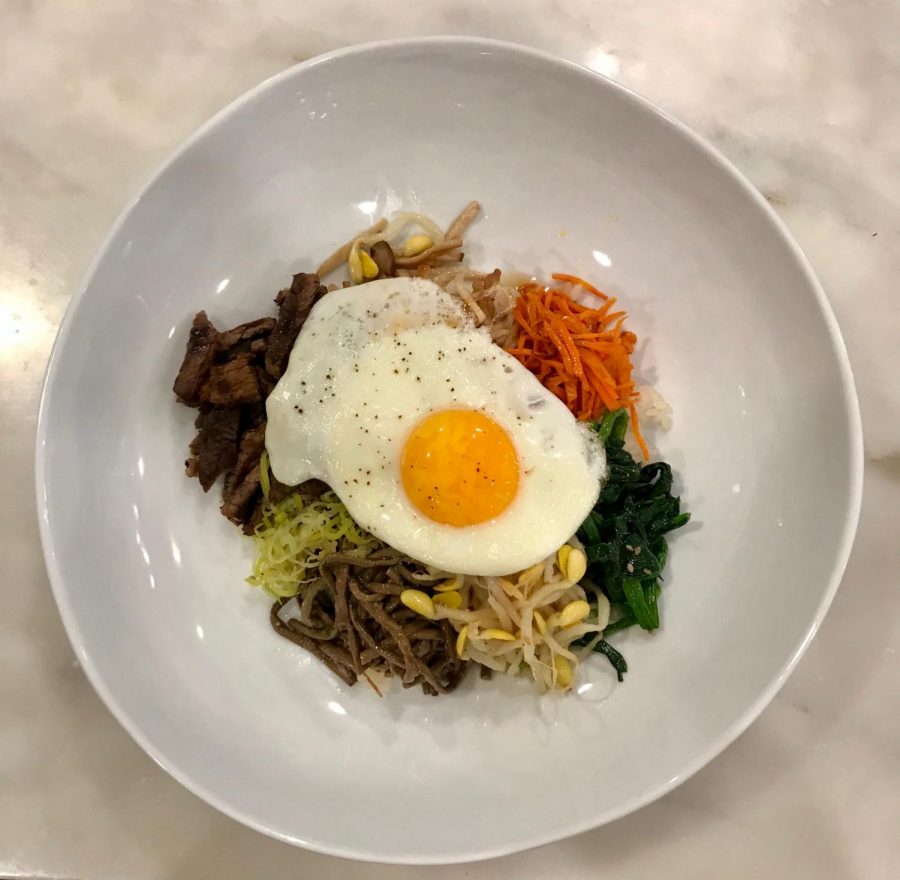Cooking & Culture: Lee’s Korean Cuisine
October 20, 2019
Credit: Heesun Lee
This Bibimbap is made from mushrooms, carrots, spinach, bean sprouts, rice, and a fired egg on top. The first bibimbap recipe came from the 19th century and traditional bowls may also include kimchi and different types of meat.
Since the nineties, the Korean Wave, as it has been dubbed, has spread to pop cultures around the world. The Korean Wave is a term used to describe the global popularity of South Korea’s exports of music, movies, style, and food. Korean food in particular has become very popular in Western culture. Social media is filled with videos of sizzling Galbi on table barbeques and fried chicken wrapped in cheese. Hackley’s New Jersey-born senior Audrey Lee is Korean and lived in Korea for three years.
“I appreciate the perspective that living in Korea has given me,” said Lee. “I think we live in a bubble in the United States and getting out of that bubble has made me have a wider view of the world.”
Lee and her family, which includes her parents and two brothers, moved to Korea when she was in 3rd grade and moved back when she was in 5th grade. Lee described city life in Seoul as “exciting” and said, “there was always something new to do”. Some of her favorite activities included going to Jeju Island, a popular beach destination in the Korean Strait, as well as exploring all there was to do in Namsan Tower.
One of Lee’s favorite aspects of living in Korea though was the food. “The food in Korea is very different than what you can find here and the quality was really good.” Though Lee misses eating authentic Korean food, she admits she doesn’t feel cheated of good Korean food in the States.
“My grandma’s a really good cook and my mom’s a really good cook so food’s really important in our family because it is something that we can all connect with,” said Lee. “My grandmother’s food is just as good as the food I had in Korea.”
One of Lee’s favorite dishes is Bibimbap, a traditional Korean dish of white rice with various toppings. Traditionally, toppings consist of Kimchi, fermented cabbage, or namul, which is a term referring to a variety of edible grasses or leaves. Many Hackley students are familiar with Bibimbab, as it is a dish served at Tarrytown’s very popular restaurant, Bibille.
Bibimbap Recipe
Traditionally, Bibimbap is a mixed rice dish with assorted vegetables and meat, but you can create your own version of Bibimbap using ingredients that suit your preferences and dietary restrictions.
INGREDIENTS FOR BIBIMBAP
Meat and meat sauce
- 4 ounces thinly shaved rib-eye steak (sometimes I use chopped up left-over steaks)
- 1 Tbsp soy sauce
- 1 Tbsp sesame oil
- 1 tsp sugar
- 1/4 tsp minced garlic
Vegetables and other
- 10 ounces spinach
- 13 ounces bean sprouts
- 4 ounces shiitake mushroom (or your favorite mushrooms)
- 1 small carrot
- 1 tsp fine sea salt
- 3 to 4 serving portions of steamed rice
- 4 eggs
- cooking oil (canola or avocado oil)
- 2 tsp minced scallion
- 1 tsp minced garlic
- 2 tsp roasted sesame seeds
- 2 Tbsp sesame oil
Bibimbap sauce
- 2 Tbsp gochujang (Korean red chili paste)
- 1 Tbsp sesame oil
- 1 Tbsp sugar
- 1 Tbsp water
- 1 Tbsp roasted sesame seeds
- 1 tsp vinegar
- 1 tsp minced garlic
DIRECTIONS
- Prepare the ingredients below.
- Mix the shaved beef with the meat sauce ingredients. Marinate the meat for about 30 mins while you are working on other ingredients. Add cooking oil into a frying pan and cook the meat on medium-high to high heat. Set it aside.
- Boil water and add a tsp of salt. Blanch the cleaned Spinach in boiling water for 30 seconds, drain, and cool in running cold water for 1-2 minutes. Squeeze the water out of spinach, then mix with 1 Tbsp of sesame oil, 1 tsp of minced scallions, ½ tsp of minced garlic, ¼ tsp of salt, and 1 tsp of roasted sesame seeds. Repeat this step for bean sprout. Set them aside.
- Clean, peel, and julienne the carrots. Add cooking oil and 1/4 tsp of salt to a frying pan and saute the carrots on medium-high to high heat for 2 to 3 minutes. Set it aside.
- Clean and thinly slice the mushrooms (if using small mushrooms like clamshell mushrooms, you don’t need to slice them. Just cut the bottom to separate the mushrooms from one another.) Add oil and ¼ tsp of salt to a frying pan and saute the mushrooms on medium-high to high heat for about 3 minutes. Set it aside.
- Mix the Bibimbap sauce ingredients in a bowl. Set it aside.
- Make fried eggs, sunny side up, on low heat.
- Put the rice into a bowl and arrange the meat and assorted vegetables on top of the rice forming a colorful wheel. Add the egg in the middle of the wheel. Serve with Bibimbap sauce and extra sesame oil on the side.
- Mix the ingredients well with the sauce and enjoy your very own Bibimbap!
